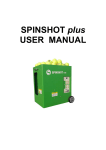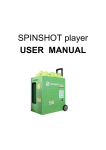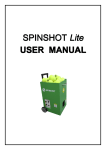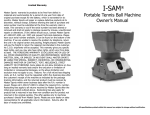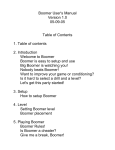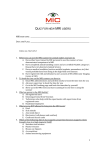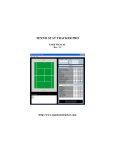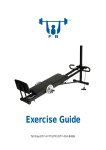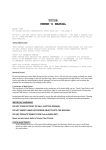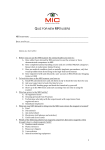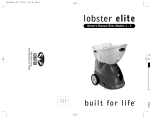Download SPINSHOT-Plus User Manual Link
Transcript
SPINSHOT plus USER MANUAL Section-1: Before Using Machine Introduction Thank you for purchasing a SPINSHOT tennis ball machine. This manual contains important information concerning the proper use and care of your ball machine. Please read owner’s manual completely before operating your machine. Tennis Balls To Be Used Please take note that brand new tennis balls are not recommended to be used especially during first ten hours of break-in period. The ink and waxy coating on brand new tennis balls can leave a slick coating on the new ball throwing wheels, resulting in inconsistent ball throws. It is best to use balls that are slightly used to reduce the potential for developing the slick coating on the wheels. The consistency of ball throws will depend on the consistency of the tennis balls being used. A mixture of new and old balls will produce inconsistent throws. Inconsistent ball throws may also be caused by excess dirt and ink build up on throwing wheels. Cleaning the ball throwing wheels as described in the section “Maintenance and Cleaning” will restore consistent performance. Important Warnings WARNING: Do not reach or look into the ball exit hole without turning the main power off and only after both wheels come to a complete stop. WARNING: Do not stand closer than 10 meters in front of the ball machine when the power is on. WARNING: Do not place balls or foreign objects into the ball hopper while the power is on. It could cause jam and damage the feeder motor. WARNING: The overloading of balls into the ball hopper may result in a jam of the feeder. It is suggested that no more than 120 balls be put inside the ball hopper. WARNING: Do not use machine while it is raining or in water. Do not use wet tennis balls. Section-2: Operating Machine Control Panel POWER: The power switch is used to turn on or off the machine. After you turn on the power, the machine will show its battery voltage on the LCD. Both horizontal and vertical motors will perform a functional initialization for proper function of the machine. Then user needs to put the machine at the centre of the baseline and in proper direction, which will make machine sweep the balls evenly across the court. Powering on the machine will not make machine start to propel balls. The user needs to select the settings and then push the “PLAY/STOP” button. After switching the power on, the machine will be default to work on manual mode without oscillation. If at anytime the machine functions improperly, the user can turn off the power button to reset machine’s control logic. Most of the time, the improper working of the machine is caused by low battery voltage. RESET: The white reset switch protects the electronics and motors. When activated, this switch pops out approximately 6mm. In the event when the reset is activated, turn off the main power, press the reset switch, check for any balls jammed inside machine and then turn on the main power to normal operation status. The “reset” can be caused by excessively dirty or slick ball throwing wheels which prevent the wheels from properly grabbing the ball. Cleaning the ball throwing wheels as described in the section “Maintenance and Cleaning” will restore proper performance. CHARGER JACK: Plug the charger into the jack and the other end into a power outlet to start the charging of your machine. REMOTE JACK: plug the remote antenna into this jack will make remote control possible up to a distance up to 50m. Start up the machine before use remote controller to control the machine. The FEED button will stop or start the feeding of the ball into the machine. The SWEEP button will stop or start the 2-line oscillation mode. Keep pressing the button for over 1 second to give an stable control. Manual Setting Buttons PLAY/STOP: The button will trigger the machine to start or stop. Every time when you press this button to start the machine, the machine will hold for 10 seconds before it propel the balls. Machine will not take any setting changes during this time. UP(+)/DOWN(-): The UP(+)/DOWN(-) button are used to adjust the manual setting parameters. Before clicking the button, the user needs to choose the type of setting to be adjusted. The types of setting include ball SPEED, ball HEIGHT, FEED frequency, SPIN level, h1-h2 and w1-w2. Please find sections below for more details about different setting types. RESET: Reserved button. ENTER: If the user needs to change the ball height when the machine is running, the ENTER button needs to be pressed after inputing the height value. The machine will not shoot any balls until the height adjustment is completed. At the initialization stage, the ENTER button has to be pressed after the user points the machine in proper direction. SPEED: The SPEED button needs to be pressed first when the user adjusts the ball speed. Then the user can press the UP or DOWN buttons to adjust the speed level (shown as RATE in LCD screen). Its value can be shown on LED with maximum level at 20 and minimum level at 1. The SPEED value can be adjusted when the machine is in running mode and will take effective immediately. FEED: The FEED button needs to be pressed first when the user adjusts the ball feed interval. Then the user can press the UP or DOWN buttons to adjust the feed rate. Its level is shown on LCD with 9 being fastest (approximately 1 ball every 1 second at the manual setting mode without oscillation). SPIN: The SPIN button needs to be pressed first when the user adjusts the ball SPIN level. Then the user can press the UP or DOWN button to adjust the amount of spin. It can set topspin or slice levels. When SPIN is set at 0, it will be flat balls. +9 represents the highest level of topspin and -9 represents the highest level of slice. The SPIN level can be adjusted when the machine is in the running mode and will be effective immediately. (See note-2 for spin level setting at vertical oscillation modes) HEIGHT: The HEIGHT button needs to be pressed first when the user adjusts the ball height level. Then the user can press the UP or DOWN buttons to adjust the height value. It will control the ball height when the machine is not running in the vertical oscillation mode. The height level can be shown on the LCD with highest level at 50 and lowest level at 1. The user needs to press the ENTER button to make the height setting take effective if machine is running. After press the ENTER button, the machine will stop shooting out balls until the height level adjustment is done. In the vertical oscillation modes, the user needs to use h1-h2 button to adjust the height oscillation range. Please see below section for h1-h2 setting. In the vertical oscillation modes, the HEIGHT button will also be used but not represent the ball height. The HEIGHT value will show the number of shoots at each height level (defined by h1, h2). h1-h2: The button is used only in the vertical oscillation modes. In the vertical oscillation modes, the machine is shooting balls at 2 height levels defined by h1 and h2. Pressing once on the h1-h2 button will give access to set the h1 level with a minimum level at 1 and a maxim level at 20. Pressing again on the h1-h2 button will give access to set the h2 level with a minimum level of 30 and a maxim level of 50. This setting is only effective when the machine is set on the vertical oscillation mode (horizontal vertical oscillation mode, 2-line vertical oscillation mode or vertical oscillation mode). w1-w2: The button is used for horizontal 2-line oscillation modes, which includes horizontal 2-line oscillation and vertical horizontal 2-line oscillation. In such modes, the machine is shooting balls to a defined width. W1 stands for the 2-line width range on the backhand side and W2 stands for the 2-line width range on the forehand side. Pressing once on the w1-w2 button will have the user set the W1 level with a minimum level of 1 and a maxim level of 9. Pressing again on the w1-w2 button will have the user set the W2 level with a minimum level of 1 and a maxim level of 9. This setting is only effective when the machine is set on the 2-Line oscillation mode (2-line oscillation or 2-line vertical oscillation). Oscillation Mode Setting and Buttons SPINSHOT-Plus model can support different oscillation modes, or a combination of oscillation modes. Overall it can support 5 types of oscillation: Type-1: RANDOM HORIZONTAL OSCILLATION; Type-2: 2-LINE HORIZONTAL OSCILLATION; Type-3: VERTICAL OSCILLATION; Type-4: RANDOM HORIZONTAL AND VERTICAL OSCILLATION; Type-5: 2-LINE HORIZONTAL AND VERTICAL OSCILLATION; RANDOM: Pressing this button will set machine to horizontal oscillation mode. In this mode, the machine will randomly shoot balls horizontally. Ball speed, height, spin and feed rate can be adjusted for the random oscillation mode. When the machine is set to the horizontal oscillation mode, the user can still press the vertical oscillation to switch the machine to RANDOM HORIZONTAL AND VERTICAL OSCILLATION mode. This is an oscillation mode combining both horizontal and vertical oscillations. For this oscillation mode, the h1-h2 setting needs to be applied to define the 2 height levels of vertical oscillation. 2-LINE: Pressing this button will set the machine to the 2-line horizontal oscillation mode. The two-line oscillation automatically shoots to two preset locations allowing a user to practice alternating forehand and backhand shots. 2-line width can be defined by w1-w2 setting as described in section of “w1-w2”. After the machine has been set to the 2-line oscillation mode, the user can still press vertical oscillation to make the machine set to a 2-LINE HORIZONTAL AND VERTICAL OSCILLATION. VERTICAL: Pressing the VERTICAL button will set the machine to a vertical oscillation mode. The vertical oscillation mode will allow for a combination of high balls and low balls. The machine will shoot balls at 2 height levels defined by h1 and h2. If machine has been in the random horizontal oscillation mode, pressing this button will set the machine to RANDOM HORIZONTAL AND VERTICAL OSCILLATION mode. If the machine has been in 2-line oscillation mode, pressing this button will set the machine to a 2-LINE HORIZONTAL AND RANDOM VERTICAL OSCILLATION mode. MANUAL: Pressing the MANUAL button will set machine back to manual mode without oscillations. This is also a default setting after power on or reset. Notes: 1. When the user needs to switch between different oscillations modes, it can be through the “SWEEP SETTING” buttons directly. In most cases, it is not a problem. However, because the machine could still be running during switching, the internal logic can work improperly by such direct switching. If this happens, the user can just turn off and then turn the machine on again to reset all the logics. 2. In the 3 types of vertical modes, the machine will shoot balls at 2 height levels. In the low height level defined by h1, the machine will deliver a flat shot without any spin even though the user defined spins. In the higher level defined by h2, the machine will be with spin as defined. This is to simulate real games with flat shots followed by lobs. 3. Each time when the user presses the oscillation button to enter a different oscillation mode, there will be a default setting shown in the LCD. Such a setting is the preferred value for the corresponding oscillation mode. 4. Keep pressing the “+” or “-“ button will continuously increase or decrease the selected values. 5. By properly positioning the machine, the user can make the machine shoot balls evenly across the court during horizontal oscillation modes. 6. The maxim feed rate setting is 9, but in oscillation mode, the feed rate can be lower than in manual mode due to internal height or horizontal motor adjustment delay. 7. The serving wheels can not slow down quickly. So in vertical oscillation mode, when machine switches from low shots to higher shots with a high spin setting it will produce shots out the back of the court if it is used with fast feed rates. 8. The high top spin setting will slow down the balls. Therefore, when machine works with high spin setting, it is suggested that the machine be set to a high speed level of over 17. Default speed setting will be 20 for spin level higher than 7. Battery Charging (for Battery Model) You need to first connect the battery charger to a live electrical outlet and then insert battery charger into the socket labeled as “CHARGER” on the control panel. The battery will be fully charged in 8 to 15 hours. The LED light on the charger pack will be green when the machine is fully charged. If LED stays red, the charging process is still continuing. A fully charged battery will provide approximately 3-4 hours of practice time. Higher ball speed requires more power and therefore will drain the battery faster. It is very important to CHARGE THE BATTERY IMMEDIATELY AFTER EACH USE. Battery Cage The battery cage enables the user to easily install and replace the battery or an AC module. Unscrew the wheel first before opening the battery cage door. Unscrew the 4 screws at the corners and then you will find 2 wires which will be connected to the battery terminals. The red wire should be connected to the red terminal and black wire to the black terminal. Care must be taken to ensure you put the battery terminals to the top left side when you insert the battery into the cage. Static Electricity It is possible that the action of the tennis balls rubbing against the throwing wheels will cause a small static electric shock when you touch the control panel. To eliminate this connect a wire from the control panel to the court surface. Transporting and Storage Remove all balls and close the ball hopper before transporting your SPINSHOT ball machine. Store the machine in a clean, dry location. Never store the machine in a closed trunk where temperatures can be very high. Extreme temperatures and conditions can affect the machine’s electronic board and battery. Never store the machine outside. Exposure to rain and snow will shorten the life of the machine. Maintenance and Cleaning It is suggested that you clean the ball throwing wheels every year or after 150 hours of use especially when the machine is not throwing the balls consistently. Clean the ball throwing wheels only when the machine is off. Firmly rub coarse sandpaper across the throwing wheels through the ball ejection opening to remove the dirt and ink build-up. Sand the entire circumference of each wheel and use enough pressure to rough-up the rubber surface of the wheels. To clean the case, use a slightly damp cloth. Do not use chemicals or abrasive cleansers. Use a vacuum cleaner to clean dirt from the inside of the machine. The use of compressed air for cleaning is not recommended. Section-3: Warranty Warranty Period The warranty service is free for materials and workmanship for a period of one year from date of original purchase except for the battery, which is warranted for three months. Scope of Warranty This warranty covers all defects in material and workmanship. The following are not covered by the warranty: Units damaged by accident, misuse, abuse, neglect Units modified by unauthorized personnel Units damaged during shipment Battery damage











